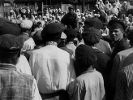Eye For Film >> Movies >> Dovzhenko: War Trilogy (1930) Film Review
Comprising Zvenigora, Arsenal and Earth – all individually striking - the War Trilogy as a whole is as deeply personal, passionate and profound as any of the other major cinematic landmarks of the 20th century. Described by David Thomson as 'the first intensely personal artist in Russian cinema', Dovzhenko's progressive approach to editing – he was one of the pioneers of Soviet Montage - camerawork and narrative construction mark him out as an enduringly distinctive voice whose films retain their importance to this day.
The three individual parts of the trilogy unfold in ways that are fitting to their respective narratives and highlight just how experimental Dovzhenko was as a director. Zvenigora, a tale of Ukrainian history steeped in mythology and superstition, plays out as a dream-like experience, replete with slow motion, super-imposed and fantasy sequences. Arsenal, a stark representation of war and its impact on social cohesion, is all expressive, angular shots, brutalized imagery, pounding orchestral score and rapid-fire montages. Finally, Earth, a more beatific exploration of collectivization, is the most linear, adopting a more readily apparent cohesion that its quasi-religious (Zvenigora) and frantic (Arsenal) predecessors eschew in favour of avant garde interpretations of social upheaval.

The relentless march of progress and the equally relentless battle between the generations, the ruling elites and the working classes and between the individual and the state form a central concern that runs throughout the trilogy, as history and tradition lock horns with modernity and the future. A knight on horseback shot in slow motion, like an indelible, lingering ghost of the country's past, at the outset of Zvenigora will later be juxtaposed with an image of a dead soldier half buried in the mud of a battle field in Arsenal, the corpse's rictus grin making an already disconcerting image surreal and horrific, as war and its effects are. That image is subsequently contrasted with genteel shots of wind rushing through fields of barley, as change rushed through Ukraine, in Earth. There is a rigorous thought process evident in the layering of images that crosses not just from scene to scene but from film to film over the course of the years.
Dovzhenko's casting of the same actors – chiefly Semyon Svashenko and Nikolai Nademsky – in different but similar roles across the three films, speaks of ties between past and present, of an inter-linking between fictional characters and actual lives, representative as the various figures played by Svashenko and Nademsky are of Ukrainian character types – be they feudal peasant, revolutionary firebrand, war veteran or collectivized, agricultural worker.
From the woozy, allegorical Zvenigora via the world-out-of-balance, montage heavy Arsenal to the contemplative, but no less impassioned, modern-pastoral vision of Earth, the War Trilogy constantly surprised with its alternating moments of beauty, reality, terror, fantasy, death, love,horror, birth and rebirth. Accompanied by three memorable scores and containing technical flourishes as fresh today as they were at the time, the War Trilogy is required, and deeply enriching, viewing for all serious film enthusiasts.
Reviewed on: 24 Sep 2012

















